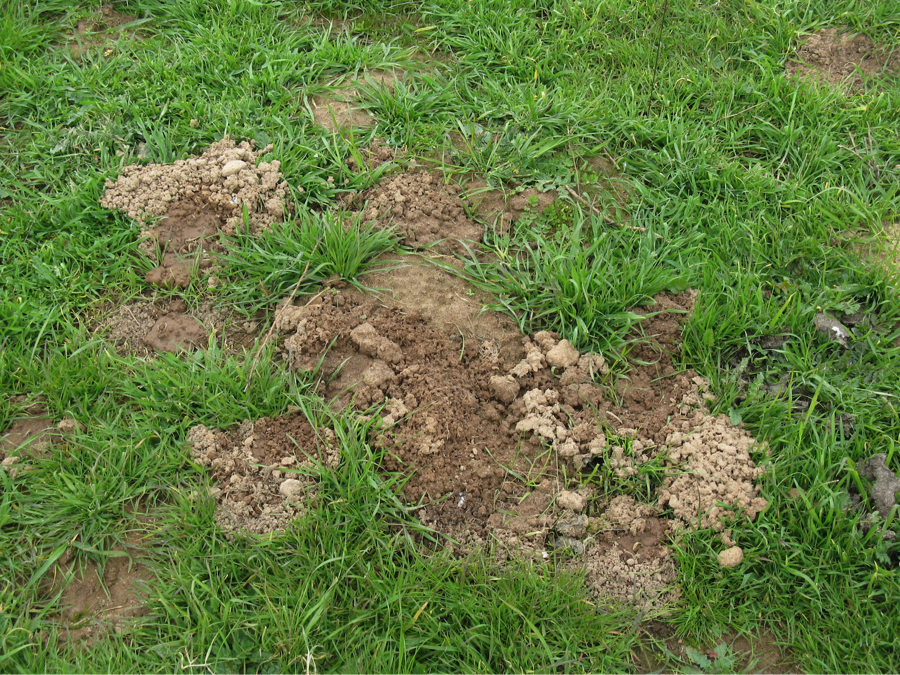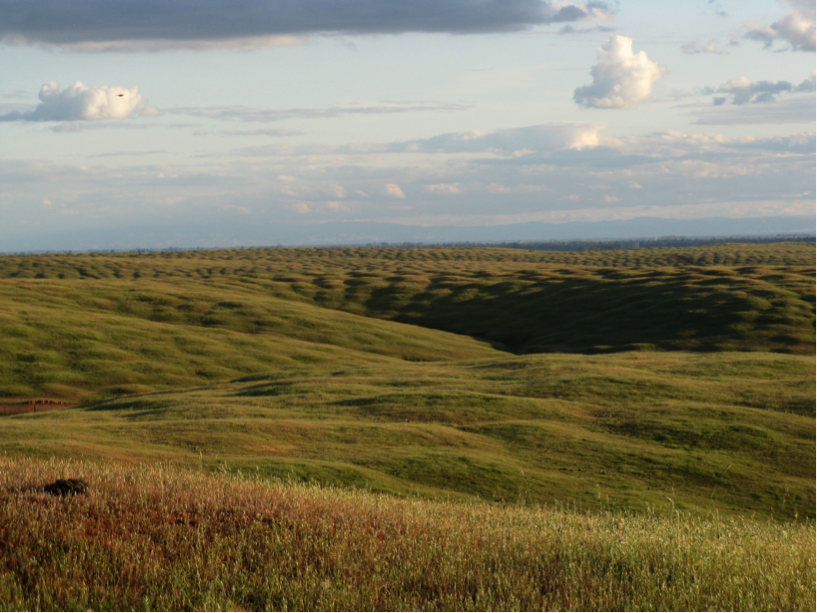By Dr. Sarah Reed, UC Berkeley. (Dr. Reed recently received her PhD, based in part on mima mounds studies she carried out in the Reserve and on nearby ranchlands)
Mound and trough are Siamese twins, joined by an invisible, crucial stratum that holds the ponded water. -- Hans Jenny
What are Mima mounds?
One of the most visually stunning, and scientifically puzzling, geologic features of North America are the small rounded hillocks called Mima mounds. Mima mounds are circular soil mounds found in grassland landscapes in nearly all states west of the Mississippi, as well as many places around the globe including South America and Africa.
A single mound is small, ranging from 1 to 50 meters (m) in diameter and 0.1 to 2 m in height1. When observing the mounds from a landscape-scale perspective, however, their density and regularity are notable. Named after mounds on Washington’s Mima prairie, Mima mounds cover large expanses of North America and can number more than 40 mounds per hectare2. In many locations, including the Merced area, the depressions adjacent to the mounds seasonally fill with water, creating vernal pools.
Figure 1. Dense Mima mounds on the ~3 million year old Laguna formation. Photo is taken looking south from the Chance Ranch adjacent to the UC Merced campus.
How did the mounds and pools form?
And how do the relatively small features persist given erosion by rain, overland flow, grazing and human activity? In spite of the global distribution, important biodiversity, and visual intrigue of Mima mounds, controversy over their origin has been ongoing for nearly two centuries
1, 3. As Higgins
4 wrote, “they are a mystery that has been discussed for over 150 years and ... have generated a greater variety of hypotheses than any other geologic feature.” More than 30 different ideas have been proposed, and most of these fall into five general categories: erosional, depositional, seismic, biologic, and shrink-swell.
Have you seen Caddyshack?
While the range of explanations is diverse, in the last several decades of research, the majority of evidence suggests that biologic forces play a key role. For my dissertation (based out of UC Berkeley with advisor Ron Amundson), I explored the hypothesis that attributes the mounds to the work of burrowing rodents, in particular, gophers. Could these pesky varmints really be responsible for millions of acres of undulating topography around the globe?
According to the biologic hypothesis, burrowing animals build Mima mounds in regions with thin, seasonally saturated soils. Given the higher risks of flooding and predation in such environments, the animals seek out deeper or better-drained locations. As they forage and burrow, which involves dislodging and moving soil in order to create an extensive tunnel system, the animals move a collection of soil backwards, toward the center of their activity. Over time, this translocation results in a local accumulation of earth, which serves as preferred habitat for subsequent generations of burrowers 5.
The organism most often implicated in this mound building is the pocket gopher. The range of pocket gophers runs from Alberta, Canada to Panama and largely overlaps the historical distribution of Mima mounds. In 1923, Grinnell6 declared the pocket gopher California’s most widespread and abundant burrowing rodent and estimated their population to be 1 billion.
Figure 2. Video showing a pocket gopher, an animal which spends nearly all of its life underground and which uses its teeth and claws to build a system of tunnels to live and forage. Video courtesy of Robert Meyer.
Pocket gophers are strikingly diverse in morphology and genetics7, 8. The fossorial mammals spend nearly 100% of their lives underground and have adapted to the conditions of the subterranean niche: negligible light, excess moisture, relatively constant temperatures, and low oxygen levels9. As a result, gophers provide an excellent opportunity to explore biologic response to changing soil conditions. Given the intimate interplay between pocket gophers and their earthen habitat and given the proposal that biologic response to particular soil conditions has led to the widespread Mima mound features, my thesis work focused on an age gradient of soils within and around the UC Merced campus, to test gopher response to changing soil conditions.

Figure 3. Typical tailings piles from pocket gopher (Thomomys bottae) tunneling. An average gopher tailings pile is ~25 centimeters (cm) in diameter. A variety of ages of tailings can be seen, ranging from older piles of sediment, which are hardened over by past rain events and/or overgrown with vegetation to new tailings piles, composed of loose soil and no overlying vegetation.
What is the evidence for the ‘gopher hypothesis’?
Many decades of research3 have provided evidence supporting a biologic hypothesis, including:
-
Mima mounds are all found in regions with thin soil layers over a dense, impermeable substratum
-
Mounds occur only within geographic range of gophers
-
Occupancy (or evidence of past occupancy) by gophers of most Mima mounds
-
Uphill and moundward (towards the mound center) movement of soil by gophers (based on tracer studies of Cox and collaborators10)
-
Mounds have soils of a size small enough to be transported by gophers
-
Larger particle sizes at base and in between mounds.
However, much of the evidence is circumstantial, observed only in small regions over short periods of time, and points to inhabitation of mounds by burrowing animals (using preexisting topography as preferred habitat), but does not directly prove that they are the builders of the mounds. In addition, the exact mechanisms of how mounds might be built by burrowing animals and how changing environmental conditions might affect such ecosystems is underexplored. (More on mima mounds next month when Sarah will provide Part 2!)
References
1 Johnson, D. L. and Horwath-Burnham, J. L. Introduction: Overview of concepts, definitions, and principles of soil mound studies. In Horwath-Burnham, J. and Johnson, D. L., editors, Mima Mounds: The Case for Polygenesis and Bioturbation, volume 490, pages 1–19. Geological Society of America, 2012.
2 Cox, G. W. The Distribution and Origin of Mima Mound Grasslands in San-Diego County, California. Ecology, 65(5):1397–1405, 1984a.
3 Washburn, A. L. Mima Mounds: An Evaluation of Proposed Origins with Special Refer- ence to the Puget Lowlands. Technical Report 29, Washington State Dept. of Natural Resources, Division of Geology and Earth Resources, 1988.
4 Higgins, C. Editorial comments on mounds. Geology, 18:284, 1990.
5 Dalquest, W. W. and Scheffer, V. B. The origin of the Mima mounds of western Washington. Journal of Geology, 50(1):68–84, 1942.
6 Grinnell, J. The burrowing rodents of California as agents in soil formation. Journal of Mammalogy, 4(3):137–149, 1923.
7 Nevo, E. Adaptive convergence and divergence of subterranean mammals. Annual Review of Ecology and Systematics, 10:269–308, 1979.
8 Patton, J. L. and Smith, M. F. Molecular evolution in Thomomys: phyletic systematics, paraphyly, and rates of evolution. Journal of Mammalogy, pages 493–500, 1981.
9 Lacey, E. A., Patton, J. L., and Cameron, G. N. Life underground: the biology of subterranean rodents. University of Chicago Press, 2000.
10 Cox, G. W. and Allen, D. W. Soil Translocation by Pocket Gophers in a Mima Moundfield. Oecologia, 72(2):207–210, 1987.
11 Wallace, A. R. The“Hog-Wallows”of California. Nature, 15:431–432, 1877.
12 Reed, S.E. (PhD Thesis) Pedologic-biologic feedbacks on the Merced River chronosequence: The role of pocket gophers (Thomomys bottae) in Mima mound-vernal pool ecosystems of the San Joaquin Valley. University of California, Berkeley / Pro-Quest, 2013. [Advisor: R.G. Amundson]
13 Marchand, D. Preliminary geologic maps showing Quaternary deposits of the Merced area, eastern San Joaquin Valley, 1976.
14 Harden, J. W. Soils developed in granitic alluvium near Merced, California. Geological Survey Bulletin (USA) 1590-A: Soil Chronosequences in the Western United States, pages A1–A65, 1987.
15 Vollmar, J. E. Landscape Setting . In Vollmar, J. E., editor, Wildlife and Rare Plant Ecology of Eastern Merced County’s Vernal Pool Grasslands, chapter 2, pages 7–54. University of California at Merced, 2002.
16Zinnel, K. C. and Tester, J. R. Plains pocket gopher social behavior. In Proceedings of the Thirteenth North American Prairie Conference. Windsor, Ontario, Canada, page 95ˆa“101, 1994.
17 Howard, W. E. and Childs, H. E. Ecology of pocket gophers with emphasis on Thomomys bottae mewa. University of California, California Agricultural Experiment Station, 1959.
18 Reed, S. E. and Amundson, R. G. Sediment, Gophers, and Time: A Model for the Origin and Persistence of Mima Mound-Vernal Pool Topography in the Great Central Valley. In Schlising, R. A. and Alexander, D. G., editors, Vernal Pool Landscapes, number 14 in Studies from the Herbarium, pages 15–27. California State University-Chico, 2007.
19 Reed, S. and Amundson, R. Using LIDAR to model Mima mound evolution and regional energy balances in the Great Central Valley, CA. In Horwath Burnham, J. and Johnson, D. L., editors, Mima Mounds: The Case for Polygenesis and Bioturbation, volume 490, chapter 1, pages 21–41. Geological Society of America, 2012.
20 Holland, R. F., and S. K. Jain. "Spatial and temporal variation in plant species diversity of vernal pools." Vernal pools and intermittent streams 28 (1984): 198-209.
21 Platenkamp, G. A. J. Patterns of vernal pool biodiversity at Beale Air Force Base. In Witham, C., Bauder, E., Belk, D., Ferren Jr, W., and Orndu↵, R., editors, Ecology, Con- servation, and Management of Vernal Pool Ecosystems-Proceedings froma 1996 conference. California Native Plant Society, Proceedings from a 1996 Conference, pages 151–160. Cal- ifornia Native Plant Society, 1998.
22 Bauder, E. T. The effects of an unpredictable precipitation regime on vernal pool hydrology. Freshwater Biology, 50(12):2129–2135, December 2005.




